项目名称——传统手工艺制作
项目类型:
(1)学期中的短期学习项目
(2)来华短期交流访问项目
特色:中国传统手工艺历史悠久,许多技艺传承了数千年的文化积淀。他们以其独特的技艺、丰富的材料、在世代相传的过程中,不断得到完善和创新,形成了独特的手工艺术风格。如刺绣,编结等技艺以深刻的文化内涵、鲜明的地域特色以及不断创新的精神,成为了中华文化瑰宝的重要组成部分。
优势:该项目曾经对俄罗斯孔子学院以及汉语桥项目中我院教师担任主讲教师,有多次授课经验。
课程安排
|
课时 |
具体讲授内容 |
教师介绍 |
中国结 |
16 |
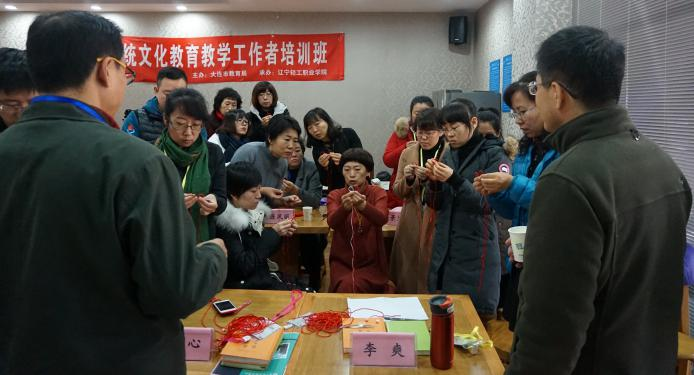
中国结,一种蕴含着千年文化的传统手工艺品,是中华民族非物质文化遗产中的璀璨瑰宝。它的美丽和神秘不仅仅在于线条的交错与缠绵,更在于背后所蕴含的深刻哲理和文化内涵。
通过讲解基本结的技法,带领学员完成两至三样服饰品。 该项目为大连市中小学师资技能提升、大连服装职业教育集团传统手工艺平台、辽宁省“教师技艺技能传承创新平台”培训学员。 |
祖秀霞,高级服装设计师,辽宁省教学名师,中国时装设计“银帆奖十佳设计师”;辽宁省十佳设计师; |
荷包 |
16 |
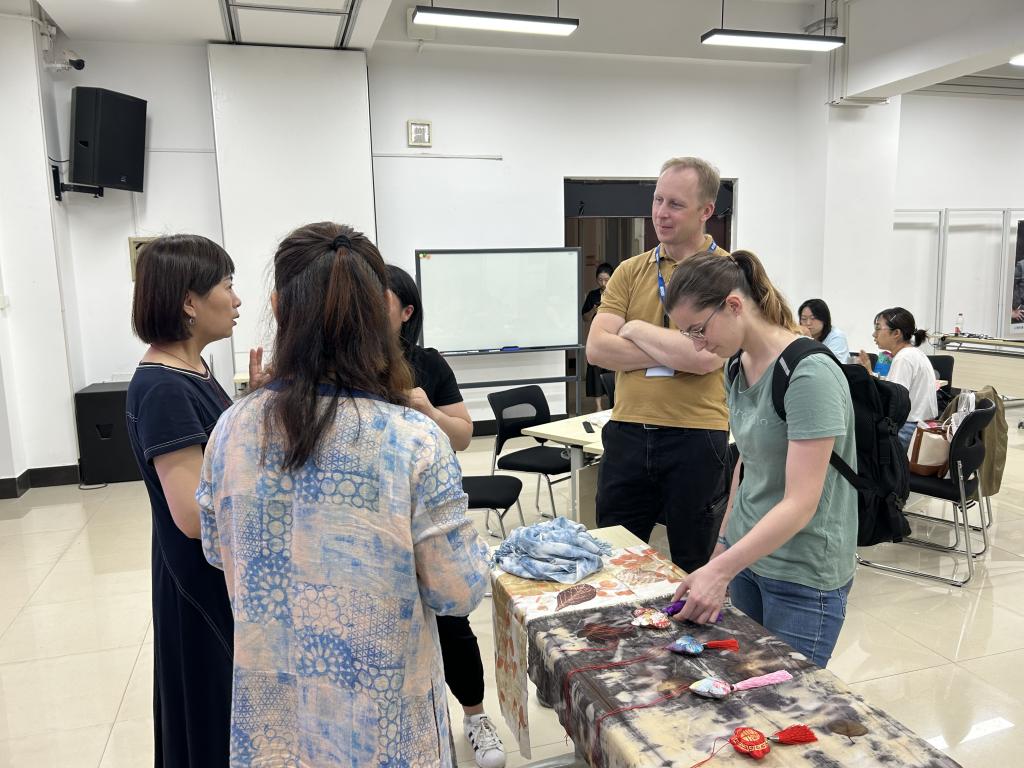
荷包是中国传统文化的物品,并且具有浓厚美好的寓意和传统韵味。通过讲解带领学员制作一个中药荷包。
该项目为大连市服装职业教育集团传统手工艺平台、辽宁省“教师技艺技能传承创新平台”培训学员。 |
辽宁轻工职业学院特聘专家宋春芳,中国工艺美术协会纤维艺术委员会理事;辽宁省非遗项目“满族荷包”第四代传承人 |
布老虎 |
16 |
|
车莉,大连市工艺美术师。 |
|
|
|
|
一、布老虎项目简介
1、特色
中国传统文化源远流长,“龙显与天,虎隐于地”龙与虎文化来自原始图腾崇拜,至秦汉建立统一帝国后,龙成为帝王的专属,虎则落入民间,成为庇佑千家万户的神明。南北的虎文化各具特色且历史悠久,“虎”被誉为百兽之王,深受百姓的尊崇,其形象又将虎的形、色、神、力、意集于一身,完美的展示了威严、健康、活泼的形象,民间布老虎就是中国“虎”文化的代表。布老虎更是我国传统文化的瑰宝。
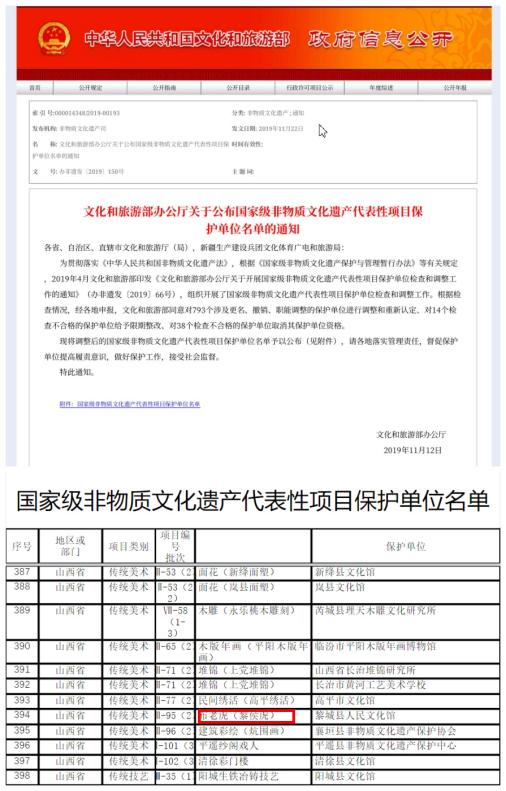
|

|
2008年6月7日,布老虎经国务院批准列入第二批国家级非物质文化遗产名录。 |
2019年11月,布老虎入选国家级非物第二批国家级非物质文化遗产名录。 |
布老虎的文化习俗---民间妇女常常通过制作布老虎如:玩具摆件虎头帽、虎头鞋、虎头枕 、老虎肚兜、虎头鞋等,来寄托孩子可以驱邪、健康、平安、强壮成长的祝福和美好愿望寓意。端午佳节,人们通过相送布老虎,来表达驱邪、纳吉的内心愿望;按旧俗,端午节期间,民间盛行给孩子们做布老虎,或是用雄黄在孩子的额头画虎脸、书“王”字,希望孩子们像虎一样勇敢强壮;成人新婚时,男女两家既要蒸面虎,还要在婚房中摆放虎头蛇尾、双头虎等布老虎。虎文化,始终贯穿于民间百姓出生、满月、婚姻、丧礼的重要礼仪当中,具有着经久不衰的生命力。除了端午节,在春节、元宵节等其他节令,以及新生婴儿百日、周岁生日时,通过赠送亲手制作布老虎形式的物件表达对孩子的心意。

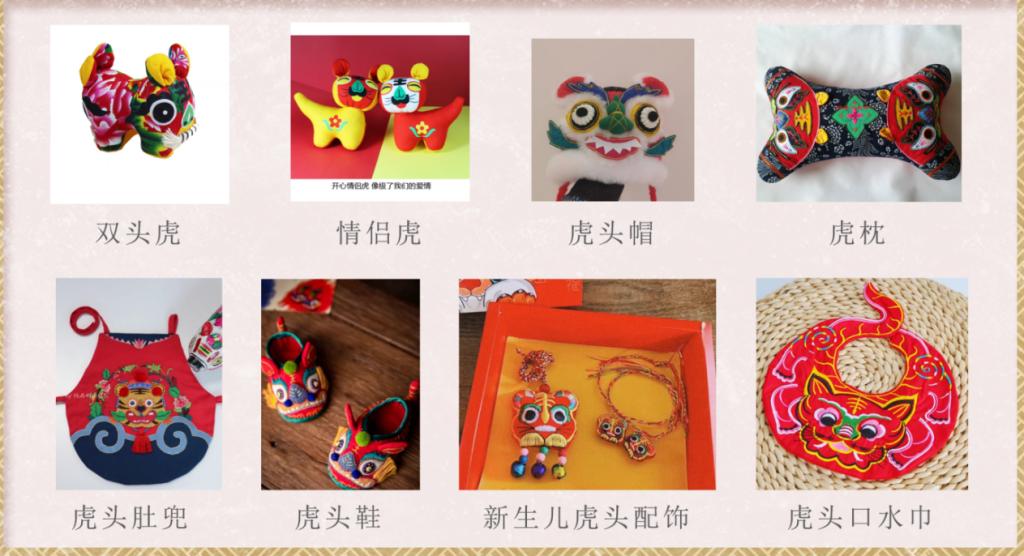
2、优势
东北地区活态调查
辽 宁 |
丹东、岫岩 |
单头虎、身体圆滚、肚大,耳小,尾巴与身体一体混圆 |
新生儿肚兜、枕头、鞋帽。 |
抚顺 |
黄白红蓝黑,体现5个方位和吉祥寓意,有贴绣和相应的符号。 |
结婚送礼越来越弱化,能够强烈体现出满族对色彩的认识。 |
庄河 |
色彩简单、鲜艳,瞪眼张嘴辟邪 |
正月新年礼送小儿的辟邪品 |
吉 林 |
长春 |
用手工粗布、艾叶填充、色彩有强烈的浅色对比色,纯度高鲜艳、一体外观制作,没有贴绣、不够立体, |
满月礼品 |
黑龙江 |
哈尔滨 |
靠近俄罗斯,颜色略暗,对比不强,立体造型感强。 |
旅游纪念品 |

目前在中国东北地区现存东北虎也岌岌可危,近年来由于野生保护法和环境意识加强,据报道时东北虎有出没,东北虎是距今可查虎类个体最大,体色、斑纹最美的一种,不仅具有很高的观赏价值,也具有着独特的生态价值。东北地区又是东北虎文化发源地,人们崇尚虎威武和健壮,浓厚的地域文化和地域特点突出,人们从小就耳听目染中,伴随着布老虎文化成长。东北地区又有本地独特文化基因:憨态圆润的形状、匍匐的动式、具有五色代表意义的色彩、大鼻子、圆眼露牙的代表的意义,需要我们传承和挖掘,布老虎形象也一代一代被华夏儿女不断传送,继续写进我们民族的骨髓中。
东北地区民间布老虎是当地百姓生活中与地域文化长期融合、积淀、凝聚而成的民俗艺术代表,其中蕴含着东北地区丰富的民俗内涵,展现出当地劳动人民的智慧与审美思想,极具传承与保护的价值。力弘扬工匠精神,保护和传承民间工艺和非物质文化遗产,推动优秀传统文化创造性转化、创新性发展。在经济全球化的背景下,文化的全球化发展是必然趋势,这为中华文化走出去创造了良好契机,我们要加快中华文化走出去的步伐,积极开展国际传播。
本课程结合当代文创产业的发展趋势,以传播中国特色文化为主线,引导学生以布老虎为灵感,开拓视野,创作新的文化产品。
虎创意的现代产品设计制作案例
3、课时、具体讲授内容
序号 |
课节 |
授课内容 |
类型 |
1 (每节课时40分钟) |
第1节 (1课时) |
项目一:介绍布老虎文化 1、了解中国东北地区地域特色; 2、东北地区布老虎文化起源、发展; |
设计制作 理论讲解 |
第2节 (1课时) |
项目二:布老虎手工---材料的准备 1、布老虎是形态、色彩、文化符号解析。 2、布老虎面料搭配; 3、布老虎色彩搭配; |
理论讲解 设计制作 |
2 |
第3节 (1课时) |
项目三:布老虎手工---纸样准备 1、布老虎纸样绘制; 2、布老虎比例分析; |
理论讲解 设计制作 |
第4节 (1课时) |
项目四:布老虎手工---裁剪面料 1、布老虎面料熨烫; 2、布老虎按照纸样裁剪; |
理论讲解 设计制作 |
3 |
第5节-第6节 (2课时) |
项目五:布老虎手工---制作身体 1、布老虎整体缝合; 2、布老虎身体填充材料; 3、布老虎身体填充开口缝合; |
设计制作 |
第7节-第12节 (3课时) |
项目六:布老虎手工---制作脸部 1、布老虎眼睛制作; 2、布老虎鼻子制作; 3、布老虎嘴制作; 4、布老虎耳朵制作; 5、“王”字制作; |
设计制作 |
4 |
第13节-第15节 (2课时) |
项目七:布老虎手工---制作整体装饰 1、贴身体花纹; 2、贴脊椎花纹; 3、装饰指头、指甲;
|
设计制作 |
第16节 (1课时) |
项目十三:东北文化教学总结 1、学生提交作品; 2、指导教师对布老虎创作演示及学生作品点评教学; 3、东北地区文化教学总结;
|
理论讲解 |
4、开课条件及教师介绍

主讲教师车莉老师,辽宁轻工职业学院讲师、大连市工艺美术师,2022年-2023年国家教育部主办的国际中文教育创新项目:《虎虎生威中国东北布老虎赏析与制作》、《琳琅满目-学满族技艺赏满族文化》《中国东北地区传统非遗文化的国际化传播---以云端中文教室为例》西班牙、美国、哥伦比亚、亚米尼亚、柬埔寨等国家的文化与制作教学。
在大学教授传统手工艺课程近30年,实地考察了我国西南边陲、东南沿海、辽宁省满族聚居区、长白山山脉等多个地区,近距离感受民间艺人,潜心研究各地传统布老虎手工艺,尤其辽宁、山西、山东、河北布老虎和布老虎造型的枕头、帽子、鞋和满族荷包等,2017年--2019年参加国家艺术基金人才培养项目3项,其中《中国东北地区满族传统手工艺青年创新人才培养》项目中满族布老虎课程学习优异。
潜心研究传统文化理论并且制作手艺精湛,学习期间创作大量的布老虎优秀、创新作品。2021年带领布老虎“虎娃”团队、传统手工艺教学中运用布老虎元素,获得2021年辽宁省第十八届职业院校技能大赛创新创业文创组比赛二等奖,2023年9月指导学生制作的《生命律动》参加辽宁省第九届大学生艺术作品展,获得省一等奖。多次参加大连国家服装博览会销售布老虎活动,拥有自己的布老虎传统手工艺工作室,带领学生积极投入布老虎研发活动,在市场销售方面也得到广大消费者的认可。
车莉老师跟随非遗传承人学习过程和部分参与省市级非遗活动
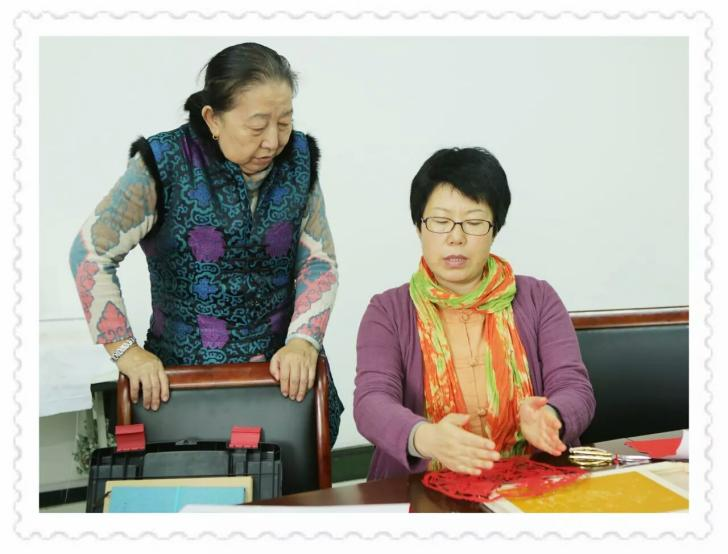
|

|
丹东七孔枕传承人介绍枕头做法 |
庄河剪纸传承人学习剪纸设计 |
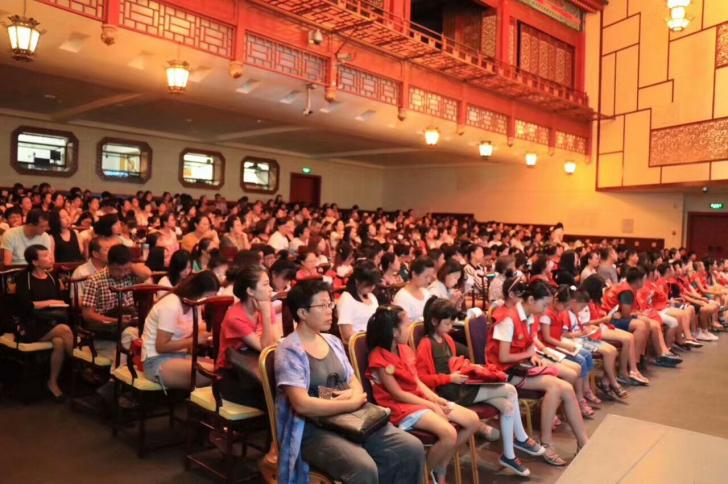
|
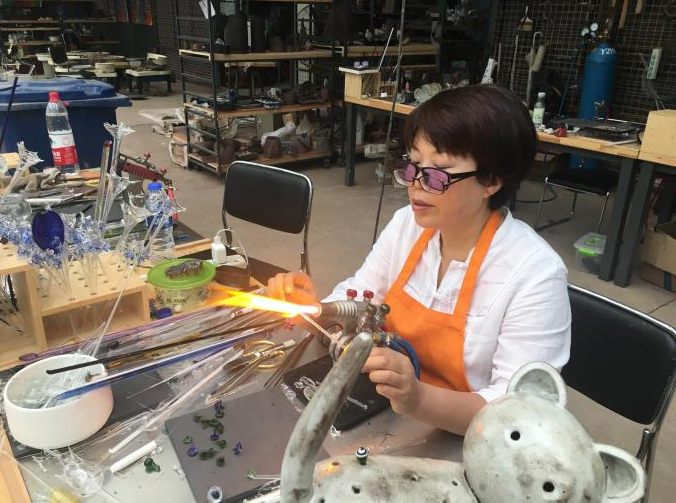
|
大连市政府举办的非遗传统文化进校园学习活动 |
国家艺术基金学习陶瓷,制作老虎形象创作 |

|
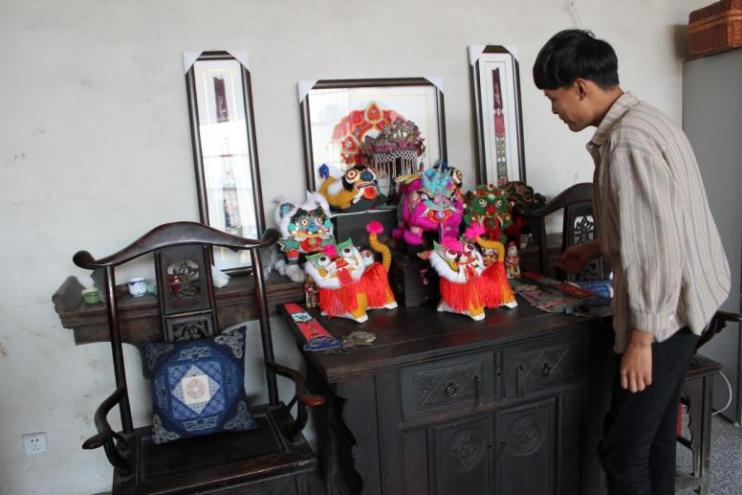
|
山东临沂拜访布老虎制作爱好者贾德友,调研布老虎传承人制作工艺 |
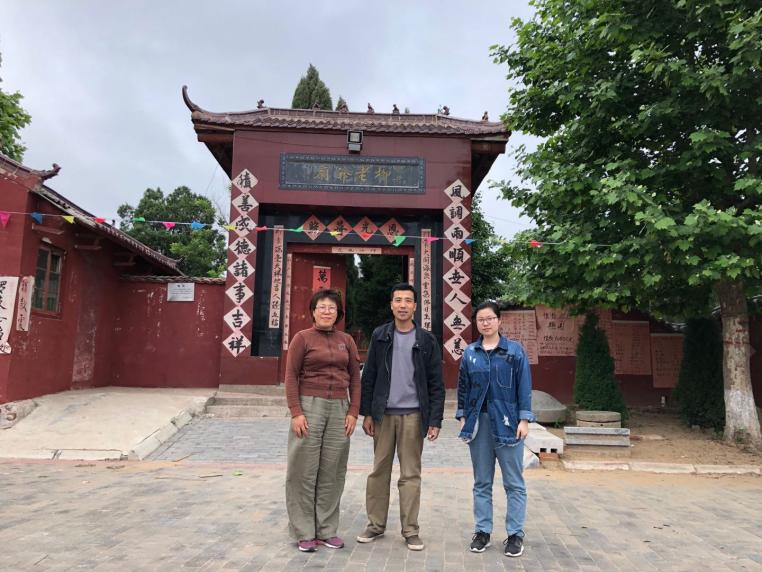
|
  |
在河南调研布老虎文化 |
长白山博物馆聆听王馆长传授满族文化 |

|
教育部主办的国际交流课程2023年1月《中国东北布老虎赏析与制作》主讲教师 |

|
车莉老师的布老虎教学和社会实践活动 |
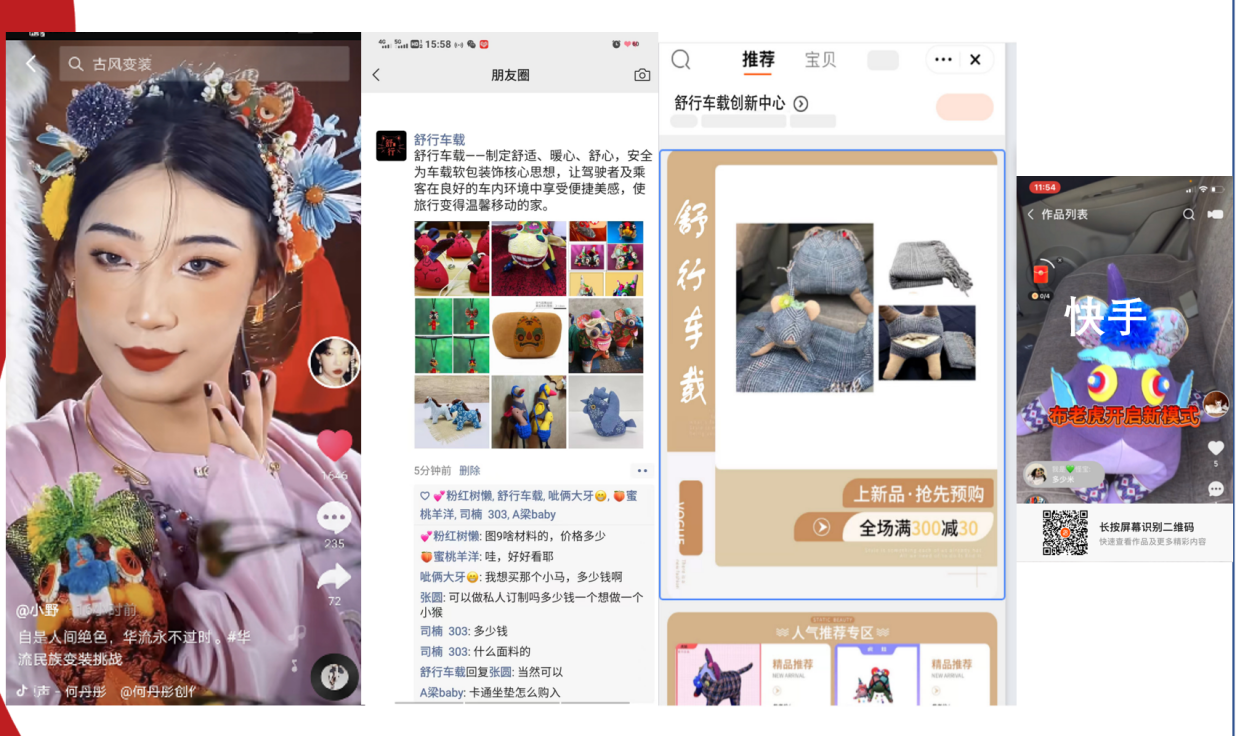
|
弘扬中国文化车莉老师布老虎宣传手段有快手、小红书、抖音进行推广 |

|
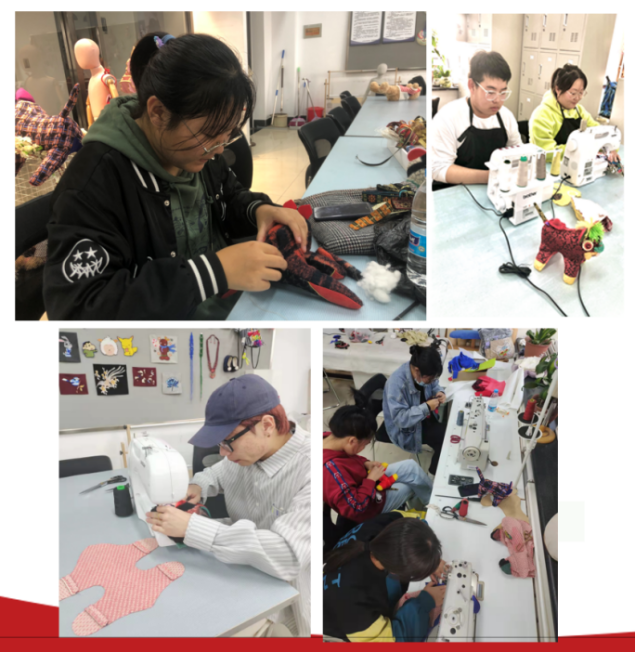
|
带动就业15名下岗、失业人员 |
在校培训学生制作布老虎500人次 |
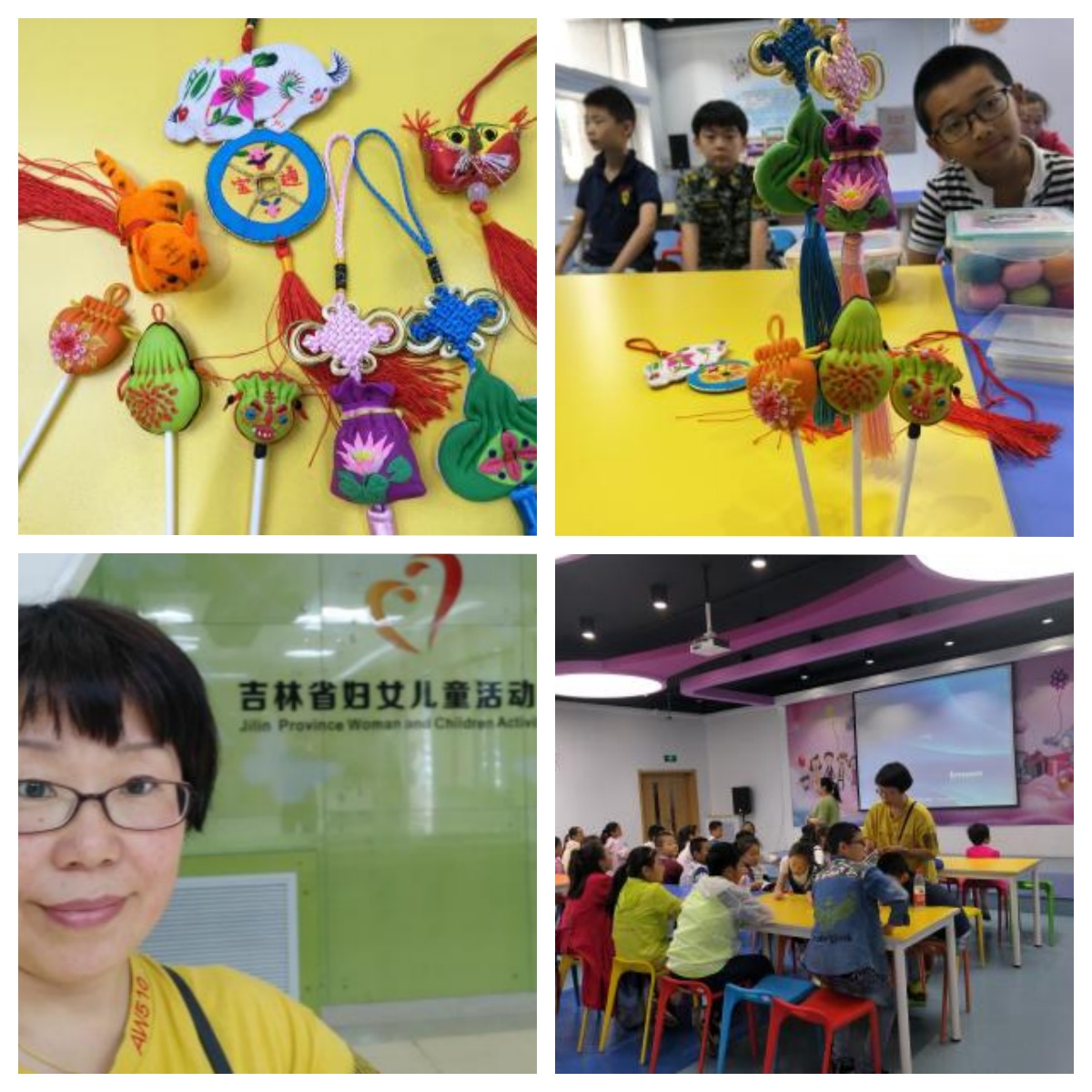
|
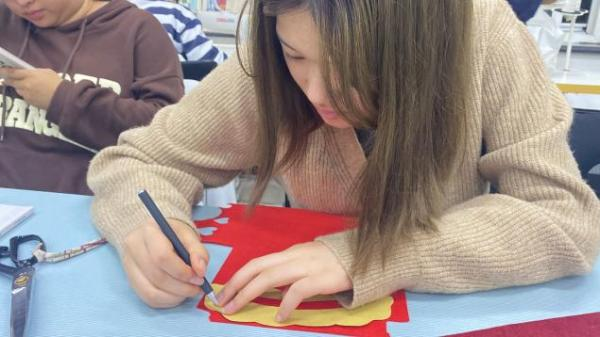
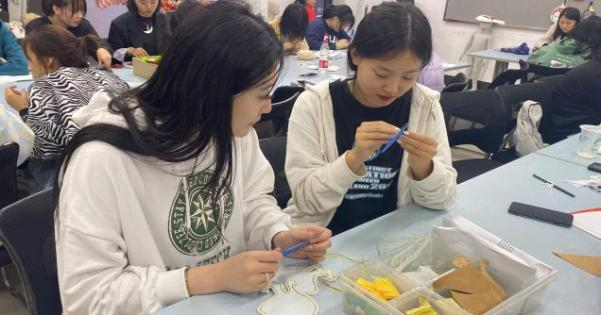
|
弘扬传统文化从娃娃抓起,过年节时期,省妇女儿童宫面授布老虎面人制作,受益儿童300多人次 |
社会布老虎爱好者培训活动20场 |
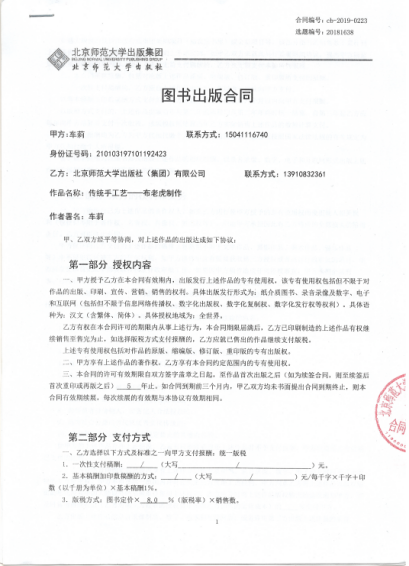
|
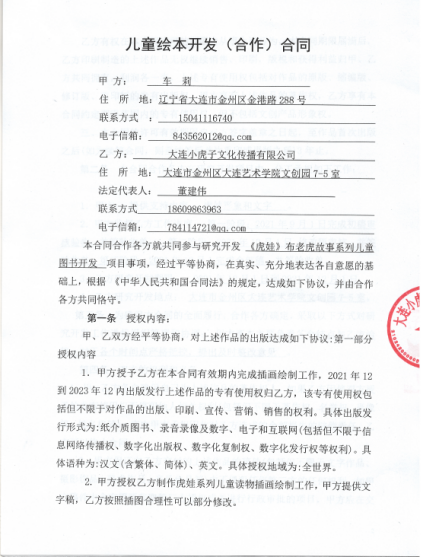
|
2021年车莉《布老虎》儿童读物出版合同 |
2019年车莉《布老虎》设计制作出版合同 |
Program Name - Traditional Handicraft Making
Program Type:
(1) Short-term study program in one semester
(2) Short-Term Exchange Programs
Features: Chinese traditional handicrafts have a very long history, and many skills have been inherited for thousands of years. With unique skills and abundant materials, Chinese traditional handicrafts have been constantly improved and innovated from generation to generation, forming a unique style of handicrafts. For example, crafts such as embroidery and knitting have become an important part of Chinese cultural treasures by virtue of profound cultural connotation, distinctive regional characteristics and the spirit of continuous innovation.
Advantages: Our lecturers for this program have served as teachers in the Confucius Institute in Russia and the Chinese Bridge Project, so they are experienced in teaching.
Course arrangement
|
Class hours |
Specific teaching content |
Introduction to teachers |
Chinese knot |
16 |

Chinese knot, a traditional handicraft with thousands of years of culture, is a brilliant treasure in the intangible cultural heritage of the Chinese nation. Its beauty and mystery lie not only in the interlacing and lingering lines, but also in the profound philosophy and cultural connotation contained in the Chinese knot. The teacher will explain the basic knotting techniques, and instruct the students to finish two or three garment accessories. This program is adopted for training students for the Dalian Primary and Secondary School Teacher Skills Improvement Platform, the Traditional Handicraft Platform of Dalian Clothing Vocational Education Group and the "Inheritance and Innovation Platform for Teachers' Skills" of Liaoning Province. |
Zu Xiuxia, senior fashion designer, famous teacher in Liaoning Province, "Top Ten Designers of Silver Sail Award" for China fashion design, and “Top Ten Designers in Liaoning Province”. |
Chinese sachet |
16 |

Chinese sachet is a representative of China traditional culture, and has a profound and beautiful connotation and a traditional charm. The teacher will instruct the students to make a Chinese medicine sachet through explanation. This program is adopted for training students for the Traditional Handicraft Platform of Dalian Clothing Vocational Education Group and the "Inheritance and Innovation Platform for Teachers' Skills" of Liaoning Province. |
Song Chunfang, specially invited expert of Liaoning Vocational College of Light Industry, the director of the Fiber Art Committee of China National Arts & Crafts Society, and the fourth generation inheritor of Liaoning intangible cultural heritage project "Manchu sachet" |
Chinese cloth tiger |
16 |
|
Che Li, Dalian industrial artist. |
International summer study program (including winter vacation), and short-term study program in one semester
I. Program introduction
1. Features
The Chinese traditional culture has a long history. “The dragon appears in the sky and the tiger hides on the earth.” The culture of the dragon and the tiger derives from primitive totem worship, after the establishment of a unified empire in the Qin and Han Dynasties, the dragon became exclusive to the emperor, while the tiger became the god protecting thousands of families. The tiger culture in the northern and southern China is distinctive and long in history. “Tiger” is known as the king of beasts and is deeply respected by Chinese people. A Chinese cloth tiger integrates the shape, color, spirit, strength and connotation of the tiger, perfectly showing a majestic, healthy and lively image. In folk, the Chinese cloth tiger is a representative of the "tiger" culture in China. Moreover, the Chinese cloth tiger is a treasure of Chinese traditional culture.

|
  
|
On June 7, 2008, the Chinese cloth tiger was approved by the State Council to be included in the second batch of State-level Intangible Cultural Heritage List. |
In November, 2019, the Chinese cloth tiger was selected to be included in the second batch of State-level Intangible Cultural Heritage List. |
Cultural customs of the Chinese cloth tiger – In folk, women often make many kinds of Chinese cloth tigers, such as toy ornaments, tiger-head hats, tiger-head shoes, tiger-shaped headrests and bellybands embroidered with tiger, to bring their blessings and wishes to children so that they can be protected from evils and grow healthily, peacefully and strongly. On the Dragon Boat Festival, people express their inner desire to exorcise evils and bring blessing by sending Chinese cloth tigers to each other. According to old customs in folk, during the Dragon Boat Festival, it is popular for people to make Chinese cloth tigers for children, or draw tiger faces and write the Chinese character of "king" on their foreheads with realgar, hoping that children will be as brave and strong as tigers. When adults get married, two families from the husband and the wife will not only make steamed tiger-shaped buns, but also put Chinese cloth tigers such as tiger-head snake-tail ornaments and double-headed tigers in the wedding room. The tiger culture has been running through important ceremonies of people in folk, such as birth feasts, full-moon-birth feasts, weddings and funerals, having an enduring vitality. In addition to the Dragon Boat Festival, people also express their good wishes for children by giving hand-made Chinese cloth tigers as presents in other festivals such as the Spring Festival and Lantern Festival, as well as on the hundredth day and the first birthday of newborn babies.


2. Advantages
Dynamic Survey in Northeast China
Liaoning |
Dandong, Xiuyan |
One-headed tiger: round in body, big in belly, and small in ears; the tail and the body are integrated to be round. |
Bellyband, pillow, shoes and hats for newborns. |
Fushun |
The Chinese cloth tiger has five colors of yellow, white, red, blue and black, representing five orientations and have auspicious meanings. There are embroidery and corresponding symbols. |
Wedding gifts become less and less common. Five colors can strongly reflect the Manchu’s understanding of color. |
Zhuanghe |
The Chinese cloth tiger is simple and bright in color, and glares and opens the mouth to ward off evils |
New year gifts for children to exorcise evils |
Jilin |
Changchun |
The Chinese cloth tiger is made of handwoven coarse cloth and filled with mugwort leaves, strong in light color contrast, high in purity, bright, integrated in appearance, no embroidery, and not stereoscopic |
Gifts for full-moon-birth feasts |
Heilongjiang |
Harbin |
Harbin is close to Russia; the Chinese cloth tiger is slightly darker in color, not strong in color contrast, but strong in three-dimensional feeling. |
Tourist souvenirs |

At present, the Amur tigers existing in Northeast China are also in jeopardy. In recent years, due to the enforcement of law on the protection of wildlife and strengthening of environmental awareness, it is reported that the Amur tigers sometimes appear. Until now, the Amur tiger has been documented to be one of the largest tigers with the most beautiful body colors and stripes. It not only has high ornamental value, but also has unique ecological value. Northeast China is also the culture birthplace of the Amur tigers, where people worship majesty and robustness of the Amur tigers, influenced by surroundings, children grow up along with fond of the Chinese cloth tiger culture having strong regional culture and outstanding geographical characteristics. There are also unique local cultural genes in Northeast China: lovely and round shape, creeping action, five colors with representative significance, big nose, round eyes and bared teeth with representative significance. The unique culture needs us to inherit and explore. The image of the Chinese cloth tiger has been continuously inherited by Chinese people from generation to generation and continues to be included into the essence of our nation.
The Chinese cloth tiger in folk of Northeast China is a representative of folk art that is formed by long-time integration of local people’s life with the regional culture, accumulation and condensation. It contains rich folk connotation in Northeast China and shows the wisdom and aesthetic thoughts of local working people, so the Chinese cloth tiger is of great value for inheritance and protection. We should vigorously promote the spirit of artisans, protect and inherit folk crafts and intangible cultural heritage, and promote the creative transformation and innovative development of excellent traditional culture. In the context of economic globalization, the globalization of culture is an inevitable trend, which creates a good opportunity for Chinese culture to go abroad. We should speed up the pace of Chinese culture going abroad and actively carry out international communication.
By combing the development trend of contemporary cultural and creative industries, this course is adopted for instructing students to broaden their horizons and create new cultural products with Chinese cloth tiger as an inspiration by spreading the culture with Chinese characteristics as the main.

|
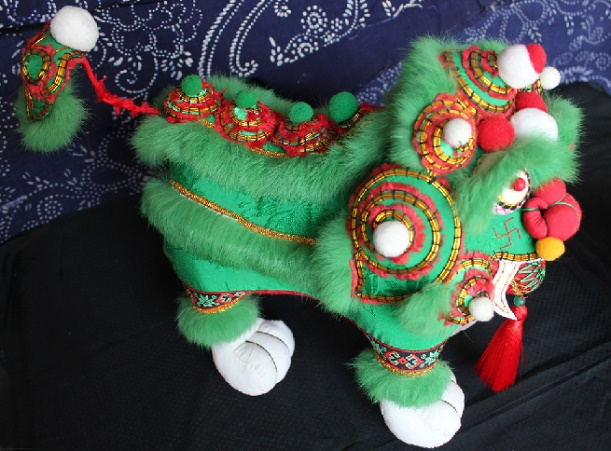
|
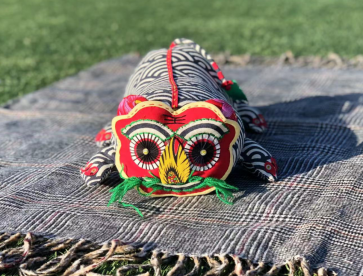
|
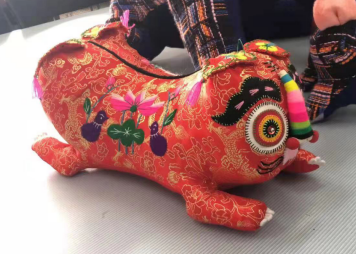
|
Chinese cloth tigers in Northeast China |
Design and making examples of modern creative products with tiger elements
3. Class hours and specific teaching content
SN |
Class |
Teaching content |
Type |
1 (40 min/class) |
1st class (1 class hour) |
Item 1: Introduction to Chinese cloth tiger culture 1. Understand the regional characteristics of Northeast China; 2. Understand the origin and development of Chinese cloth tiger culture in Northeast China;
|
Design and making Theory explanation |
2nd class (1 class hour) |
Item 2: Handwork of the Chinese cloth tiger - preparation of materials 1. Chinese cloth tiger is a symbol of form, color and culture. 2. Fabric matching of the Chinese cloth tiger; 3. Color matching of the Chinese cloth tiger;
|
Theory explanation Design and making |
2
|
3rd class (1 class hour) |
Item 3: Handwork of the Chinese cloth tiger - preparation of paper pattern 1. Paper pattern drawing of the Chinese cloth tiger; 2. Proportion analysis of the Chinese cloth tiger;
|
Theory explanation Design and making |
4th class (1 class hour) |
Item 4: Handwork of the Chinese cloth tiger - fabric cutting 1. Fabric ironing and pressing of the Chinese cloth tiger; 2. Paper pattern cutting of the Chinese cloth tiger;
|
Theory explanation Design and making |
3
|
5th class - 6th class (2 class hours) |
Item 5: Handwork of the Chinese cloth tiger - body making 1. Entire suturing of the Chinese cloth tiger; 2. Body filling material of the Chinese cloth tiger; 3. Suturing of the body filling opening of the Chinese cloth tiger; |
Design and making |
7th class - 12th class (3 class hours)
|
Item 6: Handwork of the Chinese cloth tiger - face making 1. Making eyes of the Chinese cloth tiger; 2. Making a nose of the Chinese cloth tiger; 3. Making a mouth of the Chinese cloth tiger; 4. Making ears of the Chinese cloth tiger; 5. Making the Chinese character “king” |
Design and making |
4
|
13th class - 15th class (2 class hours) |
Item 7: Handwork of the Chinese cloth tiger - overall decoration 1. Sticking of the body pattern; 2. Sticking of the spine pattern; 3. Decorating of fingers and nails;
|
Design and making |
16th class (1 class hours) |
Item 13: Teaching summary of northeast culture 1. Students submit works; 2. Instructing teachers demonstrate the creation of Chinese cloth tigers and comment on the students' works; 3. Teaching summary of northeast culture;
|
Theory explanation |
4. Course conditions and introduction to the teacher

Main teacher Che Li, a lecturer of Liaoning Vocational College of Light Industry and a Dalian industrial artist, has participated in the culture and making teaching of international Chinese education innovation programs sponsored by the Ministry of Education from 2022 to 2023 in many countries such as Spain, the United States, Colombia, Armenia and Cambodia: Tiger-Makes-Power: “Appreciation and Making Cloth Tiger in Northeast China”, “Show Time - Learning Manchu Art and Appreciating Manchu Culture”, and “International Communication of Traditional Intangible Culture in Northeast China - Taking Cloud Chinese Classroom As An Example”.
Che Li has been teaching traditional handicraft courses in universities for nearly 30 years, and has made field visits to the southwest border and southeast coast of China, Manchu inhabited areas in Liaoning Province, Changbai Mountain Region and other areas, getting a close look at folk artists. She has devoted herself to studying traditional Chinese cloth tiger handicrafts in various places, especially Chinese cloth tigers and Chinese-cloth-tiger-shaped pillows, hats, shoes and Manchu sachets in Liaoning, Shanxi, Shandong and Hebei. From 2017 to 2019, Che Li has participated in 3 talent training programs of China National Arts Fund and obtained excellent results in the Manchu cloth tiger course in the Cultivation Program of Young Innovative Talents about Manchu Traditional Handicraft in Northeast China.
She has been concentrated on the study of traditional cultural theories and has exquisite craftsmanship. During study, Che Li created a large number of outstanding and innovative Chinese cloth tiger works. Che Li has used Chinese cloth tiger elements in the traditional handicraft teaching. In 2021, she led the "Tiger Baby" team of the Chinese cloth tiger to the second prize in Liaoning 18th Vocational College Skills Competition in 2021: Innovation, Entrepreneurship and Cultural Innovation Group. In September 2023, she instructed students to make Life Rhythm for Liaoning 9th College Students' Art Exhibition, which won the first prize at the province level. She has participated in the Chinese cloth tiger selling activities in Dalian National Fashion Expo many times, has her own traditional handicraft workshop of Chinese cloth tigers, leads students to actively participate in the research and development activities of Chinese cloth tigers, and is also recognized by consumers in the sales market.
Teacher Che Li learns from intangible cultural heritage inheritors and participates in provincial and municipal intangible cultural heritage activities

|

|
The inheritor of Dandong seven-hole pillows is introducing the making practice of pillows |
Che Li is learning paper-cut design from the inheritor of Zhuanghe paper-cuttings |

|

|
Intangible Traditional Culture into Campus Activity Held by Dalian Municipal Government |
Che Li is learning ceramics at the China National Arts Fund and is making a creation of a tiger image |

|

|
Che Li is visiting Jia Deyou, a Chinese cloth tiger making enthusiast in Linyi, Shandong, to investigate the making technology of Chinese cloth tiger inheritors |

|

 |
Che Li is investigating the Chinese cloth tiger culture in Henan |
Che Li is listening to the Manchu culture taught by curator Wang in the Changbai Mountain Museum |

|
Lecturer of the international exchange course "Appreciation and Making Cloth Tiger in Northeast China" sponsored by the Ministry of Education in January 2023 |

|
Che Li's Chinese Cloth Tiger Teaching and Social Practice Activities |

|
Che Li is promoting Chinese culture. Che Li publicizes Chinese cloth tiger on Kuaishou, Xiaohongshu and Tik Tok. |

|

|
15 laid-off and unemployed workers are re-employed |
500 person-times of students have been trained to make Chinese cloth tigers in school |

|


|
Carrying forward traditional culture starts with children. During the Chinese New Year Festival, Che Li taught how to make dough Chinese cloth tigers at the Provincial Women and Children's Activity Center, benefiting more than 300 person-times of children |
20 training activities for social Chinese cloth tiger lovers |

|

|
Che Li's publishing contract for children's book Chinese Cloth Tiger in 2021 |
Che Li's publishing contract for design and making of Chinese Cloth Tiger in 2019 |